► New Volvo ES90 revealed
► Up to 435-mile range claimed
► Uses SPA2 platform like EX90, Polestar 3
The Volvo saloon is back – but not as we know it. You’re looking at the ES90, the latest EV from Volvo – and the second on its box-fresh SPA2 platform. It’s not that obvious from the pictures here, but it’s long – around 5m in length with a wheelbase of 3.1m – and it’s higher than the average saloon too, with a ride height chosen for accessibility as well as overall presence.
Like the Mazda 6e shown earlier this year, it’s also a hatchback masquerading as a saloon, for practicality’s sake. This is the spiritual successor to the S90 saloon, then, but crafted for modern consumer demands.
It also follows the EX90 as the second software-defined car from Volvo. In the same way that Apple controls the hardware and software of its products to reduce fragmentation and provide quicker, more effective updates, Volvo is unifying the tech stack across its products for the same reason.
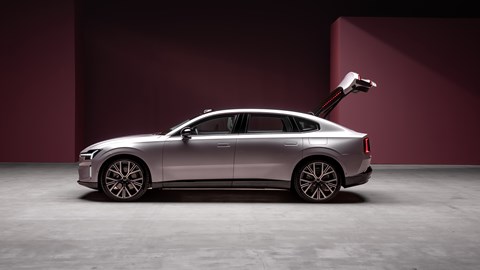
‘The Volvo ES90 combines our most advanced technologies with Scandinavian design and superior comfort, creating a true premium Volvo car designed to elevate your quality of life,’ said Jim Rowan CEO of Volvo. ‘It joins the Volvo EX90 SUV as one of our flagship models and cements our position as an industry leader in software-defined cars that harness the power of core computing.’
The new Volvo ES90 looks big?
At a limo-like 5m long, the ES90 is indeed large and robust-looking in the metal. That’s partly because of the tech underneath, but also because it’s been designed to project the safe, robust qualities Volvo has always been known for into the electric age.
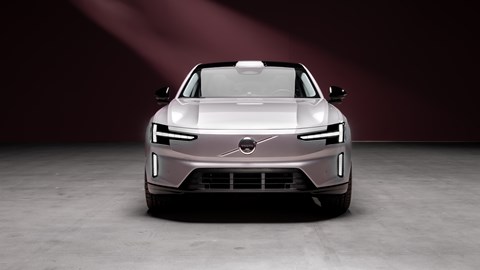
‘Volvos have always had this very stoic, practical, durable aesthetic,’ Jeremy Offer, Volvo’s head of global design, tells CAR at an early preview of the ES90 in Sweden. ‘How do we then move that on, when aerodynamics start to come into play?’
The answer? By creating a design language that looks as solid and techy as possible – whilst still cutting through the air with a respectable amount of drag (a slippery 0.25 Cd is claimed, helping eke out every extra mile of range). Volvo calls the new style ‘machined from solid.’
‘How can you tell amongst all of the cars that are on the road, that this is the safest car of them all?’ asks Offer. ‘By really carefully considering what it is that makes a car look, as well as feel, safe. The idea is that the ES90 feels like it is, and looks like it is, machined from a billet or block of aluminium, rather than pressed from sheet metal.’
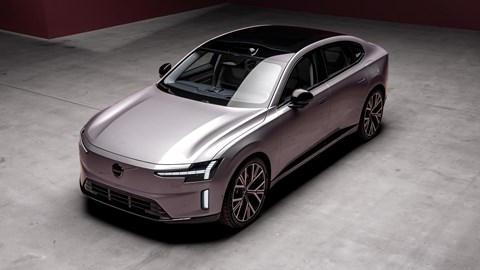
If that sounds familiar, that’s because it’s the design ethos of modern Apple Macbooks, which are largely forged from a single piece of aluminium.
The ES90’s Lidar assistance systems and sensors are exposed and prominent, positioned high above the windscreen. That’s partly because it’s the most effective location for Lidar sensors to get a good view of the road ahead, but also because Volvo’s designers wanted the ES90 to wear its safety features proudly.
Elsewhere you’ll see the latest iteration of Volvo’s ‘Thor’s Hammer’ headlight motif, and new C-shaped lamps at the rear which echo the original S90’s. New for this EV are slatted LED lamps which peep out of the rear window edges – and almost make the ES90 look like an estate from far away. As you’d expect, they’ll be used for goodbye and hello animations upon start-up and when parked.

Boot space is claimed at 424 litres, growing to 733 litres if you flop the rear seats down. There’ll be seven paint colours to choose from, and the EV will roll on one of four wheel options, ranging between 20- and 22 inches in diameter.
What are the tech specs of the ES90?
The ES90 runs on the Swedes’ latest SPA2 platform, so it’s a twin to the Volvo EX90 SUV and a half sibling to the Polestar 3. Or something like that. Either way, it uses the same ‘Superset tech stack’ as the SUV. In simple terms, both cars use the same set of hardware and software modules, so over-the-air updates can be streamlined and pushed to both models in one fell swoop when new software versions and features are ready.
The result? Updates are quicker to develop and can be pushed out to a much larger number of cars. What’s more, feedback from those cars is more relevant, so can be processed more quickly to influence further updates (with the users’ permission). It’s a virtuous circle, claims Volvo.
At the heart of the new tech stack is a duo of Nvidia Drive AGX Orin chips. Designed to power all aspects of the car’s technology, they make the ES90 the most intelligent Volvo yet, according to its makers.
‘That makes [the ES90] the most powerful car we have ever created in terms of core computing capacity,’ says Anders Bell, Volvo’s chief engineering and technology officer of the new chips. ‘This allows us to further raise the bar on safety and overall performance through data, software and AI.’
Such are the benefits of the new ‘double Orin’ tech stack, that Volvo has pledged to upgrade retrospectively the less powerful chip configurations in early EX90s and Polestar 3s. Doing so keeps the SPA2 cars on the same level, preventing fragmentation.
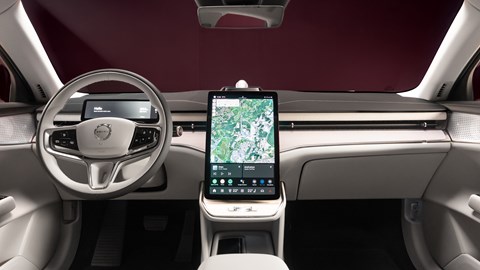
Eventually, all EX90 and Polestar 3 products will roll off the production line with the latest chips – but Volvo won’t confirm when that’ll happen.
What about the powertrain?
The ES90 will be available in a total of three trims, all of which are coming to the UK: there’ll be a range-topping twin-motor Performance model, a twin-motor ES90 and finally a single-motor.
The range-topping Performance model will develop 500kW (671bhp) and 642lb ft of torque from a 106kWh battery and two motors. The standard 0-62mph sprint will take just 4.0 seconds, says Volvo, while electric range should be 435 miles. Charging time will be 20mins when going from 10-80%, with ultra-rapid 350kW charging (if you can find it in the UK… good luck).
The mid-range dual-motor Volvo ES90 gets the same 106kWh battery, but instead delivers 330kW (443bhp) and 494lb ft of torque. Range is 435 miles, the same as the Performance, as is the charging time.
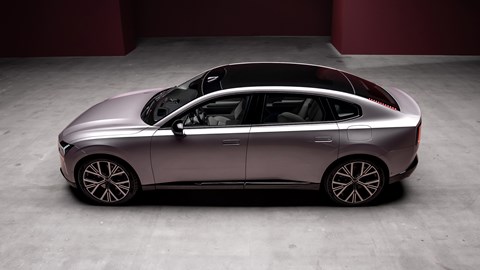
The entry-level ES90 will kick off with a single 245kW (329bhp) motor on the rear axle, paired with a smaller 92kWh battery. That’ll get you a 0-62mph sprint of 6.9 seconds, and a WLTP range of 404 miles. Charging time will take 30mins when plugged into a 350kW charging station.
Top speed is capped at 112mph (180kmh) across all three cars, though towing capacity varies: it’s 2000kg for the twin-motor models, and 1600kg for the entry-level model. All three ES90 models benefit from third-party software from Breathe Battery Technologies, a company which helps to cut charging times.
The Volvo ES90 is underpinned by 800-volt technology, whereas the EX90 it’s twinned with currently does not. Volvo says that the later EX90s will get the same 800v tech as the ES90 in time – something early adopters should rightly be frustrated about. And unlike with the chip situation, early EX90s obviously can’t be upgraded to 800v circuitry. One to bear in mind with showroom decision making…
When’s it coming out?
The new Volvo ES90 will go on UK sale in March 2025, but into production in late summer 2025 with the first UK cars arriving in the first quarter of 2026. CAR understands UK pricing should start around £70,000 and Brits can expect to be offered in Plus and Ultra trim levels, with top-spec cars weighing in at £88,000.
Thoughts on the new 2025 Volvo ES90? Be sure to sound off in the comments below!